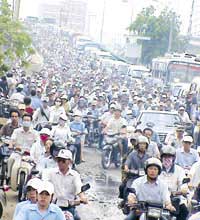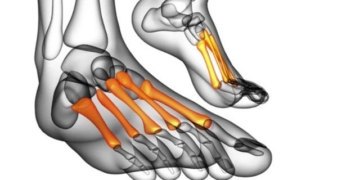From July 1, vehicles operating in five major cities—Hanoi, Ho Chi Minh City, Da Nang, Can Tho, and Hai Phong—will be required to comply with new emission standards. This move is part of a roadmap aimed at reducing vehicular emissions to protect the environment. However, with 16 million motorcycles (accounting for 96% of all motor vehicles in the country), daily emissions from these motorcycles are comparable to those from 600,000 cars on the road, yet they remain largely unregulated…
 |
|
Emissions from 16 million motorcycles remain uncontrolled. |
As of July 1, 2006, vehicles with license plates from the five cities of Hanoi, Ho Chi Minh City, Hai Phong, Da Nang, and Can Tho must meet level 1 emission standards.
For gasoline engines, the maximum allowable emissions are no more than 4.5% CO, 1,200 ppm for four-stroke engines, 7,800 ppm for two-stroke engines, and 3,300 ppm for engines with special designs. For diesel engines, the limit is no more than 72% HSU.
Vehicles that do not meet these standards will not be issued a certificate of technical safety and environmental protection from inspection stations. Vehicles from other localities must comply with this standard by July 1, 2008.
Implementing the new emission standards for operating vehicles will help reduce harmful emissions into the environment. However, there are still many challenges.
A Cleaner Environment
Starting July 1, with the new emission standards in place, although the increase is not significant (the CO concentration drops from 6 to 4.5), and still far from the standards of advanced countries, about 7-8% of vehicles have failed inspections due to smoke emissions. Even expensive, newer vehicles, and those driven by foreigners living in Vietnam, have failed inspections for not meeting the new emission standards.
It can be said that with higher emission standards and stricter controls, the environment will undoubtedly be cleaner. Gradually raising emission standards is indeed a correct approach to protecting the urban environment.
Given the current rate of economic development, the number of cars will continue to increase, especially in major urban areas. Establishing a framework for managing emissions and preventing environmental pollution is being implemented according to a roadmap and is showing positive initial results.
In 2004 and 2005, many vehicles that exceeded their service life were removed, significantly reducing harmful emissions to the environment and paving the way for higher emission standards to be applied in first-class cities, progressing towards nationwide implementation.
Challenges Ahead…
 |
|
Thick black smoke from old motorcycles |
However, many vehicle owners in the aforementioned five cities believe it is unfair that a considerable number of vehicles from cities and provinces that have not yet implemented the new emission standards are regularly circulating in these urban areas. These vehicles are still allowed to emit pollutants according to the old standards without failing inspections.
This situation may lead to vehicles registered in the five major cities being inspected in other provinces to avoid the stricter emission standards. This concern has been anticipated by the Vietnam Register Department, which has mandated that inspection stations must verify the registration locality and ensure vehicles meet the emission standards for that area before issuing certificates. Any detected fraud will be dealt with severely.
A significant issue here is that not only cars but also motorcycles contribute to emissions. Currently, there are up to 16 million motorcycles in the country (accounting for 96% of all motor vehicles in operation), while there are only about 600,000 cars.
If we consider that an average car has a cylinder capacity of 2.5 liters and a motorcycle has 0.1 liters, then 25 motorcycles would be equivalent to one car. Thus, 16 million motorcycles will emit an amount of pollution equivalent to approximately 640,000 cars. Moreover, in urban areas, motorcycles tend to operate more frequently as they are the preferred mode of transport for residents.
Images of old, worn-out motorcycles emitting thick black smoke are common sights in today’s urban landscapes. Meanwhile, these emissions remain uncontrolled, and there is no plan for phasing out old motorcycles.
Furthermore, the number of motorcycles continues to rise while their quality declines. Chinese motorcycles, priced at just a few million dong, often have engines that lack durability and proper sealing, posing a potential source of pollution in the near future.
It may be time for regulators to seek appropriate measures to control and minimize harmful emissions from motorcycles, thereby thoroughly protecting the environment.


















































